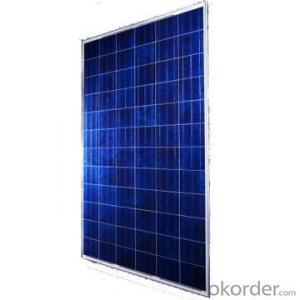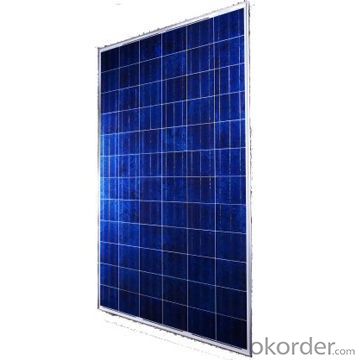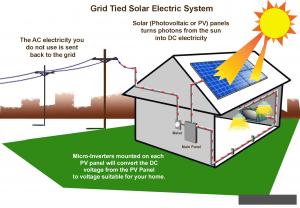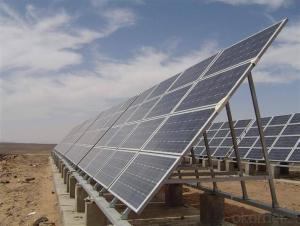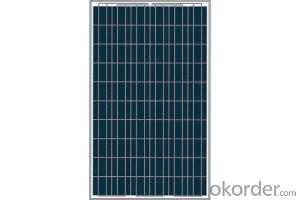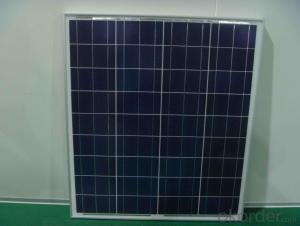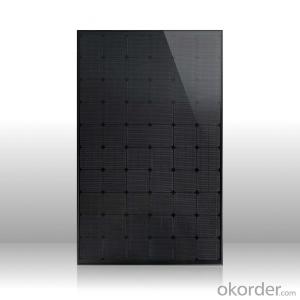Solar Panels Wyoming - 2024 150w Off-Grid Polycrystalline Solar Panel with High Efficiency
- Loading Port:
- Tianjin
- Payment Terms:
- TT OR LC
- Min Order Qty:
- 1000 watt
- Supply Capability:
- 10000000 watt/month
OKorder Service Pledge
OKorder Financial Service
You Might Also Like
Specification
Product Description
Key Specifications/Special Features
Maximum power: 150Wp
Maximum working voltage: 17.3V
Maximum working current: 8.67A
Open circuit voltage: 42.84V
Short-circuit current: 21.6A
Battery efficiency: 15%
Cell number: 72pcs (6 x 12mm)
Cell dimensions: 125 x 125mm
Solar panel dimensions: 670*1480*35mm
Maximum system voltage: 1,000V
Operating temperature: -40 to 85°C
Surface maximum loading capacity: (surface can withstand the maximum pressure) 60m/s (200kg/sq.m)
Allowable hail load (hail stress testing) steel ball fall down from 1m height
Weight of each solar panel: 16kg
Connection box type: PV-JB001 (TUV)
Cable type: with TUV mark
Cable length: 900mm ,also can according the customer's requirement to product
Output power tolerance: ± 3%
Frame material: aluminum
Standard test conditions (STC): 1,000W/m² AM1.525°C
10 years product warranty and 25 years 80% of power
Fill factor: e 72%
20-foot container quantity: 37pcs
40-foot container quantity: 700pcs
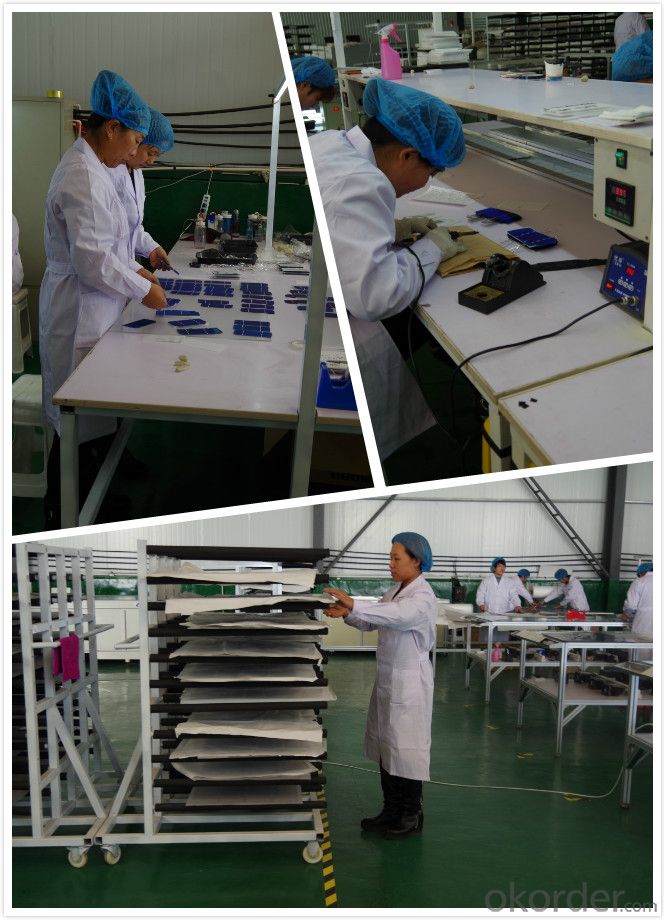
| Cell type | Poly-crystalline silicon solar cell |
| Size | 6780*480*35mm |
| Weight | 14.3 kg |
| Solar cell type | 156*156 mm |
| Number of cell (pcs) | 4*9 PCS |
| Maximum Power | 150 Wp |
| Mctual measurement results | 86.4 Wp |
| Optimum operating voltage | 17.3 V |
| Optimum operating current | 8.67 A |
| Open ciruit voltage | 21.6V |
| Short circuit current | 9.69 A |
| Power Tolerance | 1%-3% |
| Backing | TPT |
| Tempering glass thickness | 3.2 mm |
| Frame Material | Clear anodized aluminium frame |
| Operating temperature | -40 C+85 C |
| Storage temperature | from-40 C~+85 C |
| Maximum wind resistance | 60m/s |
| Surface maximum load capacity | 200Kg/M2 |
| Maximum hail load capacity | 25mm, 80km/h |
| Efficiency of panel | 14.50% |
Other Modules:
| Electrical Data | Module Size | Weight | Number of cells series | ||||
| Nominal Pwer | Max-Power | Max-Power | Open-Circuit | Short-Circuit | |||
| Voltage | Current | Voltage | Current | ||||
| Pmax | VMPP | IMPP | VOC | ISC | |||
| W | V | A | V | A | mm | Kg | pc |
| 10 | 17.2 | 0.58 | 21.6 | 1.31 | 340*254*17 | 1.2 | 36 |
| 20 | 17.2 | 1.16 | 21.6 | 1.93 | 340*460*25 | 1.8 | 36 |
| 30 | 17.3 | 1.73 | 21.6 | 1.83 | 350*670*30 | 3 | 36 |
| 40 | 17.3 | 2.13 | 21.6 | 2.45 | 460*670*30 | 3.5 | 36 |
| 50 | 17.3 | 2.89 | 21.6 | 3.06 | 560*670*30 | 4.5 | 36 |
| 60 | 17.3 | 3.47 | 21.6 | 3.68 | 670*670*30 | 5.3 | 36 |
| 70 | 17.2 | 4.05 | 21.6 | 4.29 | 758*670*30 | 6 | 36 |
| 80 | 17.3 | 4.62 | 21.6 | 4.90 | 758*670*30 | 6.5 | 36 |
| 90 | 17.2 | 5.23 | 21.6 | 5.81 | 935*670*30 | 6.7 | 36 |
| 100 | 17.2 | 5.8 | 21.6 | 6.46 | 935*670*30 | 6.7 | 36 |
| 110 | 17.2 | 6.4 | 21.6 | 7.08 | 1061*670*35 | 8 | 36 |
| 120 | 17.2 | 6.98 | 21.6 | 7.72 | 1161*670*35 | 8.6 | 36 |
| 130 | 17.2 | 7.56 | 21.6 | 8.4 | 1277*670*35 | 9.8 | 36 |
| 140 | 17.2 | 4 | 21.6 | 4.4 | 1480*670*35 | 10.9 | 36 |
| 150 | 17.2 | 4.17 | 21.6 | 4.58 | 1480*670*35 | 10.9 | 36 |
| 160 | 34.4 | 4.65 | 43.2 | 5.17 | 1480*670*35 | 10.9 | 72 |
| 170 | 34.4 | 4.94 | 43.2 | 5.49 | 1172*983*35 | 11.7 | 72 |
| 180 | 34.4 | 5.23 | 43.2 | 5.81 | 1172*983*35 | 11.7 | 72 |
| 190 | 34.4 | 5.52 | 43.2 | 6.14 | 1260*983*35 | 14.6 | 72 |
| 200 | 34.4 | 5.81 | 43.2 | 6.5 | 1260*983*35 | 14.6 | 72 |
| 210 | 34.4 | 6.1 | 43.2 | 6.85 | 1488*983*35 | 14.6 | 72 |
| 220 | 34.4 | 6.4 | 43.2 | 7.08 | 1488*983*35 | 15.2 | 72 |
- Q: Can solar panels be used to power a gas station?
- Yes, solar panels can be used to power a gas station. Solar energy can be harnessed through the installation of solar panels on the roof or in the vicinity of the gas station. This renewable energy source can then be used to power various operations and equipment at the gas station, reducing reliance on non-renewable energy sources and lowering overall operational costs.
- Q: Can solar panels be used in space?
- Yes, solar panels can be used in space. In fact, they are extensively used in space missions to generate electricity from sunlight, as there is no atmosphere to block or scatter the sunlight in space. The International Space Station and various satellites rely on solar panels to power their systems and equipment.
- Q: Is there a free site or resource that will teach you how to do this? Hopefully step by step and tells you how to buy all the parts ect?Which is the best resource for sale earth4energy, homemadeenergy, ect? Do they actually work and also as well as those which are professionally done?They say it will cost under $200 for a panel, but how much will this panel actually produce I mean how many panels would you have to make to produce 00% of your homes energy?
- there are plenty of free sites that tell you how to install your own solar panels. Just google diy solar panels. as to how many panels you need, it depends on what all you're trying to have them run.
- Q: What materials are solar panels made of?
- Solar panels are typically made of silicon, which is a semiconductor material, along with other components such as metal frames, glass, and protective layers.
- Q: Can solar panels be leased or financed?
- Yes, solar panels can be leased or financed. Many solar companies offer leasing options where the panels are installed on your property and you pay a monthly fee for their use. Alternatively, solar panels can also be financed through loans or financing programs, allowing you to purchase and own them over time while making affordable monthly payments.
- Q: I want to get a solar panel to run a fan (or two) for swamp coolers.I'm not looking to power 20box fans, just maybe some of those auto fans.What the heck kind of panel do I need? What is a power inverter and what does it do?Will I lose all my power if I use a 00' extension cord?How do I choose what I'm going to need?
- Any fan you find in a store is going to expect AC, not DC, which is what solar panels produce. An inverter changes DC to AC. You'll probably want a deep cycle car battery to smooth out overages and underages. Any fan will tell you how many watts it uses. Panels should (i haven't looked) tell you how many watts they produce. Just off hand, I'd guess you're looking at a 2'x4' panel. Considering how much you'll be paying for the rest of the stuff, a good 00' cord is appropriate,. Last, it's worth the experience, but you'll never recover the cost of everything that you'll have to buy. Have fun.
- Q: What is the average size of a solar panel?
- The average size of a solar panel is typically between 3 to 4 feet wide and 5 to 6 feet tall, with an area of around 15 to 20 square feet.
- Q: What is the typical warranty period for solar panels?
- The typical warranty period for solar panels is around 25 to 30 years.
- Q: I want to get definate instructions on how to make the components and convert my home to solar energy. I know I could hire some one to do this, but frankly I do not have the funds at my disposal to do it. I thought if I could find detailed instuctions I could slowly do it myself (with my husband's help). I have looked into loans for this purpose to no avail. Finding the information on the net could take forever! If anyone knows a site that would give me the information or even a hint on how to start? Any help will be appreciated, but if you have any good links to good information please share them with me..Thanks
- Typical solar panels like Engineer describes require a lot of space. A single panel may only light a single light bulb. You may want to look into a different way of generating electricity with solar, it doesn't use a cell to turn the sunlight into electricity, instead it uses mirrors to focus the sunlight onto a pipe between the mirrors. The heat causes water or another liquid in the pipe to boil and the steam created turns a turbine that produces the electricity. It has the potential to be less high-tech, more forgiving of minor design and structural problems and more affordable. I don't know of any system that is privately available but you can get more info at the link below. They're building a full test facility in Nevada right now. You could presumably cobble something like this up on your own.
- Q: how the energy of load connected to solar PV measure.?Want too the basic idea about it.The role of current flowing thrugh the load?Can u explain with example..can explain simply?Im not an electrical student so explain very basics
- A solar panel is made up of solar cells. Each cell produces about 0.5 to 0.6 volts. Cells are connected in series, like the batteries in a flashlight. Enough cells are placed in series to produce the desired voltage. Cells produce very little current, so many strings of cells are connected in parallel to produce sufficient current. The output is direct current (DC), like that from a battery. A home solar system needs alternating current (AC), so an inverter is used to change from DC to AC. Some systems have batteries for backup power. In these some of the DC output is used to keep the batteries charged. Systems are measured in kilowatts. System sizes are chosen to meet the demands for electricity. My system has a 6 kilowatt (kW) rating. The true output is more like 4. Now that you know this much you can Google SOLAR SYSTEMS to learn more.
Send your message to us
Solar Panels Wyoming - 2024 150w Off-Grid Polycrystalline Solar Panel with High Efficiency
- Loading Port:
- Tianjin
- Payment Terms:
- TT OR LC
- Min Order Qty:
- 1000 watt
- Supply Capability:
- 10000000 watt/month
OKorder Service Pledge
OKorder Financial Service
Similar products
Hot products
Hot Searches
Related keywords
